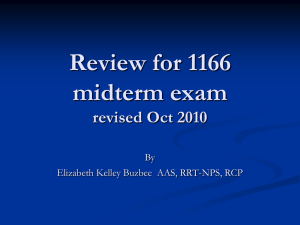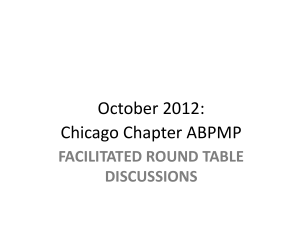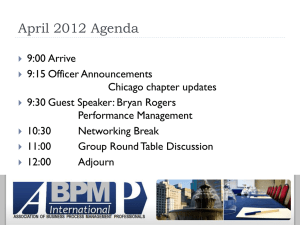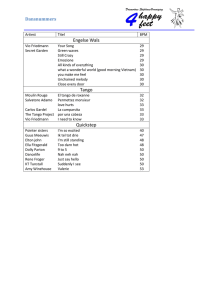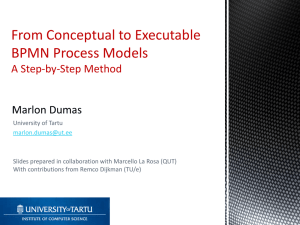Review for RSPT 1166 clinical written final
advertisement
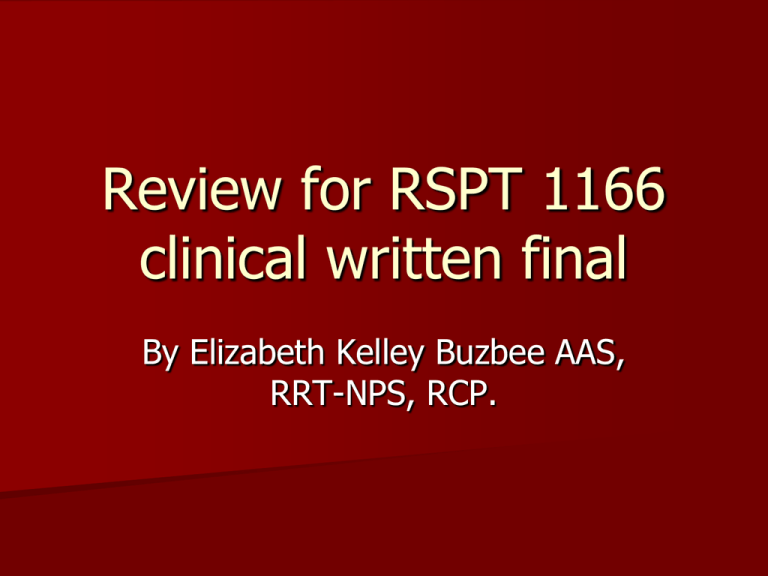
Review for RSPT 1166 clinical written final By Elizabeth Kelley Buzbee AAS, RRT-NPS, RCP. Question: Case study You walk into a patient’s room and notice that his RR is 3 bpm and that his skin is dusky. You feel no pulse rate at the carotid artery. What is the first thing you do? answer Call for help; Establish an airway and give 2 good breathes with a bag/mask with 100% 02 Question When you give your two breathes, you notice that the chest doesn’t rise. What do you do? answer Manipulate the head and neck and try again question While you give two breaths and the chest rises, the second RT in the room should be doing what? answer They should start chest compressions at a rate of 100 bpm at 30:2 ratio until the AED or the defibrillator arrives Question If the patient responds to the AED and has a carotid pulse of 70 bpm, but still is unconscious and apnic, what do you do? answer with a pulse of 70 bpm, we can stop chest compressions, but because the patient is unconscious we need to ask for an artificial airway [intubation] and because he is apnic, we rescue-breathe with bag/mask at 100% at a rate of 10-12 bpm. Once we stop compressions, we can trust the Sp02 reading, so we can use that to monitor the success of our bagging. End of case study question Identify the effect of severe hypoxemia on the heart. answer any hypoxemia can cause tachycardia, even arrhythmias if the heart is already irritable but moderate to severe hypoxemia will result in vasoconstriction of pulmonary capillaries so that right ventricular work of the heart is increased Cor pulmonale is right heart failure secondary to long-standing lung disease Question Your patient has a Pa02 of 65 torr, PaC02 40 mmHg on an Fi02 of 45%. Assume that the PB is 760 torr Calculate his P(A-a) Calculate his a/A ratio answer To figure the P(A-a)D02 & a/A, we must first find the PA02 PA02 = [ (PB – H20) X FI02] – (PaC02/.8) PA02 = [ (713) .45] – (40/.8) PA02 = 270 mmHg P(A-a)D02 = 270 – 65 = 205 a/A ratio = Pa02/PA02 65/270 = .24 question List the s/s of chronic lung disease: What do you hear What do you see What do you feel answer You will see a person with increased AP diameter You might see use of accessory muscles of inspiration and exhalation You will hear wheezing, prolonged exhalation, ‘distant’ Breath sounds [this is different from ‘diminished.’] On percussion, you will hear hyper-resonance. On palpation of the belly, you might feel muscle tensing during forced exhalation question Your patient has a Pa02 of 48 torr on room air. His Sp02 is 85% What do you recommend? answer I would give supplementary 02 to get the Sp02 above 90-92% Because I have the Pa02 48 torr on an Fi02 of .21, I could calculate the required Fi02 to get an predicted Pa02 of 80 torr. Pa021: Fi021 as Pa022 : Fi022 48: .21 as 80: x 48x = .21 (80) X = 16.8/48 X= .35 We need to increase the Fi02 to 35% to get the Pa02 back to normal [80 torr] question Your patient has the following ABG on 2 lpm: How do we correct this Pa02? Is this patient some one in whom we need to worry about 02 induced hypoventilation? pH 7.369 PaC02 HC03- 43 24 Pa02 57 answer To correct a Pa02 of 57 on 2 lpm. First we estimate the Fi02 is 20 + (2 x4) = .28 Pa021: Fi021 as Pa022 : Fi022 57: .28 as 80: x 57x = .28 (80) X = 22.4/57 X =.39= increase the Fi02 to 39% or 40% This patient doesn’t have chronic hypercapnia because the PaC02 is normal [35-45] Question Your patient’s ABG are as follows: Is this patient a person with chronic hypercapnea? How would we correct this patient’s Pa02 if this ABG was on 28% entrainment mask? pH 7.36 PaC02 HC03- 51 28 Pa02 43 answer This patient’s ABG is consistent with COPD because it has a high PaC02 with a normal pH I need to correct the Fi02 to get a Pa02 between 55 and 60 torr. Pa021: Fi021 as Pa022 : Fi022 43: .24 as 60: x 43x = .24 (60) X = 14.4/43= increase the Fi02 33% to get predicted Pa02 of 60 torr Question In the patient situation that was just completed, why can we safely increase this patient’s to Fi02 33% when we ‘know’ 1-2 lpm or 24-28% is considered ‘safe’ for persons with chronic hypoxemia and chronic hypercapnia? answer Once we have an ABG, we can use the actual Pa02 to figure our next step. We use 1-2 lpm as a ‘safe place to start,’ but if we need to give our COPD patient a NRM to get the Pa02 between 55-60 torr, we do so. only by getting the Pa02 above 65 torr can we cause 02 induced hypoventilation So it’s not a safe Fi02 but a safe Pa02 Question The patient is on 50% entrainment by bland aerosol mask. How do we correct this ABG? pH 7.369 PaC02 HC03- 43 24 Pa02 188 answer Because the PaC02 is normal, we can correct to 80 mmHg We would decrease the Fi02 Pa021: Fi021 as Pa022 : Fi022 188: .50 as 80: x 188x = .50 (80) X = 40/188= .21 While monitoring the HR, RR and Sp02, you should be able to safely discontinue the 02 Question Your patient has a RR 35 bpm with a estimated VTof 500. If he is getting 02 via a 60% entrainment mask running at 10 LPM, is this a high flow system for him? Explain your answer. answer His VE = 35BPM x .500 VT = 17.5 LPM The total flow of a 60% device at 10 LPM is 10 LPM + [10 x 1] = 20 LPM Remember 60% is an air : 02 ratio of 1:1 To be a true high flow system for this patient, his total flow must be equal to VE ( I + E ) So 17.5 [1+ 1.5] = 17.5 x 2.5 =43.7 LPM. He needs 43.7 LPM of total flow to avoid entrainment of air. He is only getting 20 LPM so there will be air entrainment so the delivered Fi02 will be less than 60% question Describe the effects of going too long between checking on a heated aerosol going to a patient with a tracheostomy collar. answer aerosols will rain out into the tubing and heated aerosols will rain out even faster. The RCP must check a trach collar patient at least Q 3-4 hours & drain the hose and a heated trach collar may need to be dumped even more often [Q2-3 hours] The extra water in the tube can obstruct the flow to the patient and it can literally drown the patient if this water tips into the unprotected airway. Because this water is dirty compared to the lower airway, this can be a source of infection Even if you have placed a water trap into the circuit, the weight of the water could pull the hose apart or pull the collar off the patient’s neck. Heated hoses are helpful, but even they will need to be drained periodically question Explain what would happen to the ability of a tracheostomy collar to deliver 02 correctly if water was to collect in the low spot [dependent] in the tubing. answer This is kinda tricky: The back pressure created by the obstruction down stream from the entrainment device will cause the lateral pressure to rise so that less air is entrained into the device. Fi02 At the outlet of the aerosol generator, we will get an increased Fi02 with a decreased flow rate As the water fills up the hose, there will be less flow rate downstream from the obstruction, so even if there is a higher Fi02, it may not get to the patient. So the patient’s delivered Fi02 is less. question Identify the approximate Fi02 of a nasal cannula at 2 lpm and at 5 lpm. Why is this only approximate? answer The Fi02 of a N/C at 2 lpm is 20 + (2 x 4) or .28. The Fi02 of a N/C at 5 lpm is 20 + (5 x 4) or .40. These are only estimates because the nasal cannula is a low flow system & the more the patient’s VE rises, the lower the delivered Fi02. question How do we add humidity to a simple mask? answer We use a cool bubble humidifier question Explain what will happen if the flow rate going to the simple mask was to exceed the ability of the bubble humidifier to allow the flow through the device answer the soft plastic sides of the humidifier will swell and if there is a pressure pop-off, it will alarm as the pressure rises above 2 psig. and if it is compensated, the flow meter will show the correct [lower] flow rate The patient’s delivered Fi02 will drop and no twisting of the flow meter knob will increase the flow to the patient question Your patient has the following Orders: keep Sp02 above 92%. What Fi02 should he be on? Time device Flow rate/Fi02 Sp02 HR/ RR 900 N/C 2 lpm/ 28% 89% 118/29 1100 N/C 3 lpm/ 32% 93% 115/22 1300 N/C 4 lpm/ 36% 94% 115/22 answer The order says keep Sp02 above 92% so We need to decrease the flow rate to 3 lpm where the Sp02 rose to 93%. While there is nothing wrong with a 94% Sp02, the order only requires getting the oxygenation above 92%. You always go with the lowest amount that can do the job question Your patient has the following Orders: keep Sp02 above 92%. What Fi02 should he be on? Time device Flow rate/Fi02 Sp02 HR/ RR 900 N/C 1 lpm/ 24% 86% 118/29 1100 N/C 2 lpm/ 28% 89% 115/28 1300 Simple mask 6 lpm/ 44% 95% 110/27 answer We need to decrease the flow rate on the simple mask to 5 LPM and recheck the Sp02. If the patient’s Sp02 is still above 92%, then we must put the nasal cannula back on at 4 LPM because we cannot have a flow rate on the simple mask below 5 LPM. question Explain why we cannot keep the simple mask at 4 lpm? answer We need at least 5 lpm to blow off the exhaled C02. As a patient re-breathes his C02, the PaC02 will rise making him to breathe faster and deeper as his CNS reacts to the increased H+ in the CSF question Your patient has been sent home. The doctor orders an MDI of Flovent 2 puffs BID at home. List the things the patient needs to know about giving himself a MDI of Flovent. answer 1. 2. 3. 4. 5. The Flovent is an inhaled steroid-not a Beta II so it is not a rescue drug He needs to use a spacer to keep medication out of his mouth & to get more into his airways He needs to rinse his mouth to minimize oral fungal infections He needs to take a slow deep breath with each puff followed by an inspiratory hold for 5-10 seconds He needs to take this BID which means in the AM and in the PM [about 12 hours apart] question Your patient is going home and he is get get MDI of Albuterol 2 puffs Q 6 hours & PRN. He will also get Atrovent MDI QID and Flovent TID. What will you tell him about scheduling? answer Q 6 hours means that he will take MDI of Albuterol every 6 hours PRN means that he can take a few extra as needed TID means that he takes the Flovent 3 x a day, basically with meals QID means that he takes the Atrovent 4 x a day. Meal times and bedtime question At what time you give the next treatment of Albuterol & Atrovent if both are ordered Q4 hours? time device Flow rate /Fi02 comments 830 SVN w/ 2.5 mg Albuterol .5 mg ipratropium bromide 6 lpm HR 89/23 HR 89/22 Wheezing unchanged. answer We would schedule the next treatment for 12:30 noon. question Describe the effect of an obstruction in the 02 line coming from a Thorpe tube answer If the Thorpe tube is compensated for backpressure, the rise in pressure upstream from the obstruction will cause the flow meter to read the correct flow rate. If the Thorpe tube wasn’t compensated, the rise in back pressure would result in an erroneously lower flow than the patient is actually getting question Describe the effect of an obstruction in the 02 line on the delivered flow rate coming from a Bourdon gauge that is calibrated for flow rate. answer Bourdon gauges are not flow meters; they read pressure only, but occasionally they are calibrated in LPM so that a Bourdon gauge may be used as a uncompensated flow meter. When there is an obstruction downstream, the Bourdon gauge will read the back pressure as increased flow rate, so it will display an erroneously high flow rate question Your patient is being transferred from the ER to the ICU. He is on a NRM at 12 lpm. His Sp02 displays 90%/HR 89 bpm. After going through various doorways, you notice that the NRM reservoir bag is deflated, the Sp02 is showing: 88%/HR 115 bpm. The flow meter on the Bourdon gauge shows a flow rate of 15 lpm. The humidifier is alarming Is there a disconnection or is the tubing pinched? answer If there was a disconnection, the bag would be deflated due to drop in flow. If there was a disconnection, the flow rate would be the same. There is no humidifier alarm for disconnection If there was a pinched line, the bag would be deflated due to drop in flow. If there was a pinched line the Bourdon gauge would show the back pressure as increased flow rate. Many bubble humidifiers have excessive pressure popoff valves and these valves will alarm in the face of an occlusion that results in high pressure. question Your E cylinder has 1500 and the patient’s flow rate is 2 lpm. How long will a tank last if your hospital policy is to change out a tank when there is 15 minutes left. answer Your E cylinder has 1500 and the patient’s flow rate is 2 lpm. Duration = psig x factor/ LPM Duration = 1500 x .28/ 2 LPM Duration = 420 liters/ 2 LPM Duration = 210 minutes 210-15 = 195 minutes 195minutes/60 = 3.25 hours .25 hours x 60 = 15 minutes So this tank will run out in 3 hours & 15 minutes question Your H cylinder has 1150 and the patient’s flow rate is 5 lpm. How long will a tank last if your hospital policy is to change out a tank when it reaches 500 psig? answer Your H cylinder has 1150 and the patient’s flow rate is 5 lpm. In this case we first subtract 500 psig so that we start with 650 psig Duration = 650 x 3.14/ 5 LPM Duration = 2041/ 5 LPM Duration =408.2 minutes Duration = 6.8 hours Duration = 6 hours + [.8 x 60] Duration = 6 hours and 48 minutes Question Case study You patient is 1 day post op abdominal surgery. His Sp02 is 93% HR 92 bpm, RR 23 bpm. His respirations are shallow and without retractions. You hear diminished basal BS and crackles over the RML. What would you suggest for this patient? answer His Sp02 is good and he shows no s/s of respiratory distress One day post op, his respiratory rate may be decreased because of pain or sedation His BBS demonstrate the presence of atelectasis, so we need to start him on Incentive Spirometer question What would be the clinical significance of this patient’s LOC for successful Incentive Spirometry? answer He must co-operate, so while he can be sleepy or even lethargic [this means arousal with stimulation] he cannot be comatose or in a vegetative state. If he is severely mentally retarded or have dementia, he may not be able to follow directions. If he is alert, but suffers a neuromuscular disorder, he may lack the muscle strength or coordination to follow directions question If the patient in the above question is a 35 YO BM who is 5 feet 8 inches tall, what would be a reasonable goal to start him on with the IS? answer To cough effectively he needs to get 15 ml/Kg IBW IBW = 105 + [8 x 6] 105 + 48 = 153 pounds To convert to kg = 153/2.2 = 69.5 kg To cough effectively he needs to get [69.5kg x 15ml.kg] or 1042 ml IC Before surgery he could easily have gotten 3 x that, so over the next couple of days we will work up to [1042 x 3] or 3.1 Liters question On his first IS, your patient gets 850 ml on his goal. What would you tell him? answer You did a wonderful job with this but we need to increase the goal to 1000. Try this again and this time hold your breath for 5-10 seconds We need to do this for at least 10 breaths question To assess the success of this patient’s IS treatment, you would want to recommend what actions? answer I would compare HR & RR before & after IS I would listen to BBS and should hear increased basal breath sounds and decrease in crackles after sucessfull deep breathing and coughing Over the next few days: I would monitor the temperature for infection resolution the X-ray for resolution of atelectasis question If this patient complains [c/o] pain on deep inspiration, what can you recommend? answer If he complains of pain on deep inspiration, I would alert the nurse that he needs pain medication. If it is an IV, I can try the IS in about 5-10 minutes If it is a shot in the arm or buttocks, I will have to wait for 30 minutes If it is a pill, I will have to wait 30-45 minutes question How would you recognize the presence of atelectasis in your post-op patient? answer On inspection, the increased WOB associated with decreased compliance seen with significant atelectasis would be obvious in retractions, increased RR and HR and use of accessory muscles If severe decreased gas diffusion, we might start getting decreased Sp02 & cyanosis from hypoxemic hypoxia On auscultation, we would hear crackles and diminished basal breath sounds On palpation we might have poor chest excursion On percussion there will be dullness question What would you want to recommend if the Incentive spirometry seems to be failing to treat the atelectasis? answer If this patient cannot get an IC of 10 ml/kg, we need to start IPPB at 15 ml/Kg IBW If the patient can get an IC of 10 or more but there is documented [X-ray] worsening atelectasis, we need to start IPPB at 15 ml/Kg IBW End of case study question You charted the wrong HR after a SVN with 2.5 mg Albuterol and 3 ml of 20% acetylcystiene. How do you correct this entry? answer I would draw a single line through the wrong word and put the correct HR just above it. Then I would initial and date the error. question Why can we not use erasable ink or pencil on charting? answer The chart is a legal document that can be used in court. All entries must be legible even the ones that have been noted as ‘errors.’ question If your patient had a PEFR that was 300 lpm and his predicted was 600 lpm, do you think this patient has a restrictive defect or a obstructive defect? Answer If your patient had a PEFR that was 300 lpm and his predicted was 600 lpm, he has a decreased PERF which means he has narrowed airway and increased RAW So he has an obstructive defect Case study # 2 Question Your patient is a 45 YO WF whose IBW is 65 kg. She has X-rays w/ atelectasis in the RML and RLL. She has crackles everywhere and diminished BS over the RLL. Her RR is 29 bpm and HR is 103 bpm & she has a fever of 103 What do you recommend? answer Incentive spirometer and deep breathing can prevent atelectasis, but once it is severe enough we need to start IPPB at 15 ml/Kg IBW. If the patient cannot get 10 ml/Kg IBW on IS, we need to advance to IPPB Question You start the IPPB at a rate of 6-8 bpm. You see that the manometer goes back to -2 then moves up to +12. the inspiratory time is about 3 seconds long. You measure a VT of 500 ml at these parameters. What do you recommend right now? Answer a rate of 6-8 bpm is OK for IPPB. Too fast and we worry about air trapping and decreasing the Cardiac Out put The sensitivity needs to be set so that the patient can trigger the breath by -2 cmH20 or less pressure. This is OK An inspiratory time of 3 seconds is too long; increase the flow rate to decrease the inspiratory time. a 500 ml is too low [500/65 Kg] or 7.9 ml/Kg IBW…so we need to increase the VT by increasing the PIP to get 15 mL /Kg [or 975 ml.] End of review

